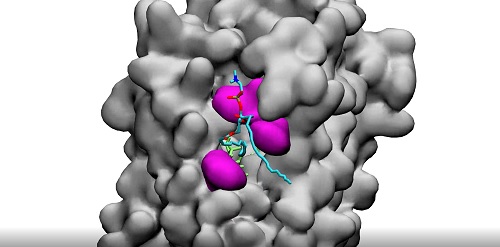
27 March 2025 - Press notes
Previously unknown access points in cell membrane proteins have been discovered, enabling laboratory-developed drugs to modify cell function.
The discovery was made possible through computer simulations with an unprecedented level of detail. The results are available online to support the development of new, targeted drugs for a wide range of diseases.
Research centers from thirteen countries collaborated on the study, which has been published in Nature Communications.
Cell membrane proteins hide secret gateways that can be used to modify cell behavior. This has been demonstrated in a study led by the Hospital del Mar Research Institute and published in Nature Communications, with participation from research centers in Spain, Switzerland, the United Kingdom, Germany, France, Poland, the Netherlands, Denmark, Hungary, Italy, Sweden, China, and the United States. The findings may facilitate the creation of new medications or improve the mechanisms of existing ones.

Members of the team responsible from the work. Left to right, Brian Medel, Marta López, Jana Selent, Alejandro Peralta, David Aranda, Miguel Diéguez, Adrián García
The study's findings are based on computer simulations that achieved an unprecedented level of detail. Researchers were able to observe, at atomic scale and in real time, how membrane lipids interact with G protein-coupled receptors (GPCRs) in their natural environment. These interactions reveal new ways to modulate cellular functions that would otherwise remain invisible. "We have discovered new gateways for drugs to modulate proteins that regulate cellular activity," explains Dr. Jana Selent, coordinator of the GPCR Drug Discovery Research Group within the Biomedical Informatics Research Program (GRIB) at the Hospital del Mar Research Institute, a joint group with Pompeu Fabra University.

Image showing the simulation of the opening of a 'cryptic' ligand-binding site in a GPCR of the PAR2 (Protease-Activated Receptor 2) type by a lipid (in blue), in gray
GPCRs are important because a significant portion of existing drugs target them to act on cells. In fact, 34% of FDA-approved drugs are based on these receptors. "Having detailed information about the specific site where these drugs act within the cell will accelerate the development of targeted therapies," adds Dr. Selent.
Although the study published is based on data from 190 experiments covering 60% of known GPCRs, the work continues to uncover the mechanisms used by these proteins to regulate cell function. So far, researchers have confirmed that beyond the known access points, there are others only visible through computer simulations. These newly identified pathways could be leveraged to develop innovative therapeutic treatments. According to Dr. David Aranda, postdoctoral researcher at GRIB and lead author of the study, these are "more specific gateways for each receptor-a more direct way to modulate cell behavior."
In many cases, it was known that a drug acted on cells, but not how. These results shed light on this aspect of cellular dynamics, making it possible to identify "targets that help create more selective, more precise medications, thereby reducing possible side effects. This could allow us to go beyond current methods used in treating multiple conditions," he adds.
This information, along with future findings, is freely available for use by any laboratory working on developing or improving medications.
Aranda-García, D., Stepniewski, T. M., Torrens-Fontanals, M., García-Recio, A., Lopez-Balastegui, M., Medel-Lacruz, B., Morales-Pastor, A., Peralta-García, A., Dieguez-Eceolaza, M., Sotillo-Nuñez, D., Ding, T., Drabek, M., Jacquemard, C., Jakowiecki, J., Jespers, W., Jiménez-Rosés, M., Jun-Yu-Lim, V., Nicoli, A., Orzel, U., Shahraki, A., ... Selent, J. (2025). Large scale investigation of GPCR molecular dynamics data uncovers allosteric sites and lateral gateways. Nature communications, 16(1), 2020. https://doi.org/10.1038/s41467-025-57034-y
Parc Salut Mar
Passeig Marítim 25-29 Barcelona 08003
See location on Google maps
Phone: 93 248 30 00 · Fax: 93 248 32 54
Information request
© 2006 - 2025 Hospital del Mar · Legal notice and Privacy Police | Cookie Policy | Accessibility